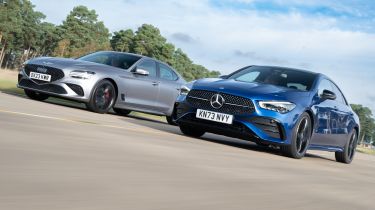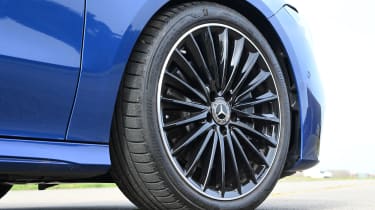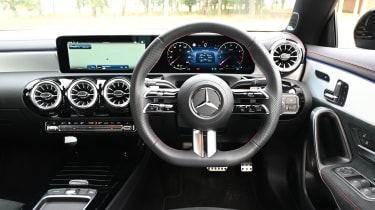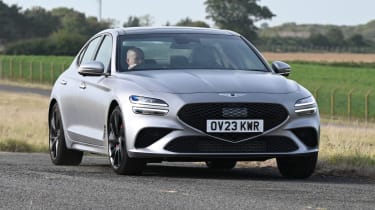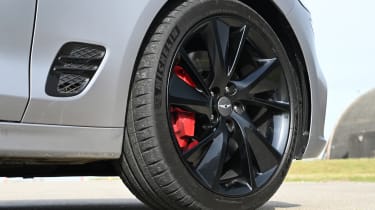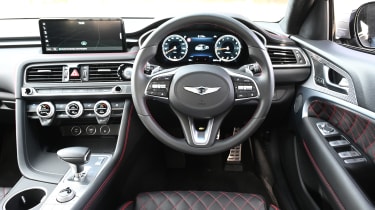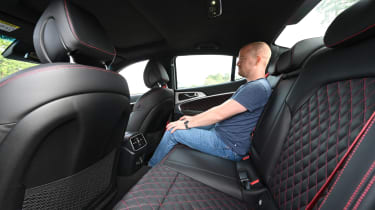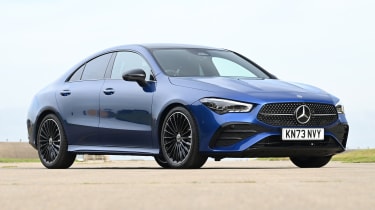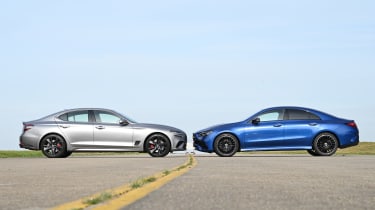Mercedes CLA vs Genesis G70: Germany faces Korea in our junior exec shoot-out
Stylish four-door models from Mercedes and Genesis go head to head, as the updated CLA takes on the G70
With so many SUVs and electric cars undergoing the Auto Express Real-World Road Test, it’s something of a breath of fresh air when we get a pair of petrol-powered saloons together.
We say saloons, but Mercedes classifies the CLA as a coupe, much like the larger — and now discontinued — CLS. For the benefit of this test we’re going to overlook that classification, but we’ll definitely be keeping a close eye on the range of updates that Mercedes has recently introduced, as we try it in mild-hybrid CLA 200 guise.
Given that the car has low-slung, sporty looks, but isn’t necessarily the first car to come to mind when you think of a Mercedes saloon, it felt appropriate to line up another left-field choice against it.
The Genesis G70 all but matches the CLA in length and is priced similarly, although it does come with rear-wheel drive where the CLA sends power to the front wheels. Does that give the Genesis an advantage for driving fun? Or can the CLA beat its rival with a broader mix of talents?
| Mercedes CLA 200 AMG Line Premium | Genesis G70 2.0T Sport | |
| Price: | £41,425 | £41,470 |
| Powertrain: | 1.3-litre 4cyl turbo petrol mild-hybrid, 161bhp | 2.0-litre 4cyl turbo petrol, 241bhp |
| 0-62mph: | 8.4 seconds | 6.1 seconds |
| Test efficiency: | 38.2mpg/8.4mpl | 32.3mpg/7.1mpl |
| CO2: | 143g/km | 181g/km |
| Annual VED: | £170 | £180 |
Mercedes CLA
Recent updates to the Mercedes A-Class line-up have also found their way to the CLA, so there’s a cleaner look and additional kit, including the introduction of mild-hybrid tech to the petrol models. Here we’re testing the CLA 200 in AMG Line Premium trim, which starts from £41,425.
Tech highlights
As already mentioned, the CLA’s updates mirror those of the A-Class. That’s because both models are based on the same MFA2 platform, which also underpins the B-Class, GLA, GLB and their electric EQA and EQB equivalents.
Used - available now

2023 Audi
Q4 Sportback e-tron
54,526 milesAutomaticElectric
Cash £23,363
2022 Kia
Niro
18,315 milesAutomaticPetrol1.6L
Cash £17,900
2023 Nissan
Juke
40,858 milesManualPetrol1.0L
Cash £12,287
2022 Volkswagen
T-Roc
36,779 milesAutomaticPetrol1.5L
Cash £18,600The CLA has the same wheelbase as the A-Class, but it’s longer overall to accommodate its saloon rear end. The car’s flowing lines and low roof mean Mercedes has fitted doors with frameless windows, and that is largely the reason why it’s called a coupé (plus the fact that an A-Class saloon also exists).
The updates in 2023 concentrated on a reprofiled nose with a new diamond grille for all models, plus new LED lights front and rear, while the latest MBUX infotainment system was added inside. Mechanical revisions saw the introduction of a 48-volt mild-hybrid system on the petrol cars to boost efficiency, but the 1.3-litre powerplant — which is the result of a joint venture with Renault — remains the same.
Lighting: Mercedes is a market leader for headlight technology, and all versions of the CLA have LED units with adaptive main-beam assist that deliver a bright field of view at night.
Premium Plus models feature Multibeam, which automatically dips the main beam in sections when traffic is detected ahead. Also included are neat start-up and shutdown animations that activate whenever the car is locked or unlocked.
On the road
In a world of bloated SUVs, the CLA proves to be quite nimble, but there are compromises.
Around town: Light steering boosts the CLA’s agility, while all versions come with front and rear sensors, a reversing camera and park assist to help you in and out of spaces. However, smooth low-speed manoeuvres are hampered by a jerky throttle response and grabby brakes, while a firm ride means that broken surfaces can be felt easily.
Forward visibility is fine, but while the C-pillars aren’t as thick as they are in an A-Class, the CLA’s narrow back window limits rear visibility instead.
A & B-roads: Things improve with speed, and on faster country roads the CLA 200 is more enjoyable. With 161bhp on tap, it’s not the quickest car in a straight line, and there’s plenty of noise as the 1.3-litre engine gets up to speed, but the seven-speed twin-clutch gearbox responds well to keep the engine in its power band, and the chassis offers plenty of grip. The balance is neutral on the whole, with the car pushing towards understeer as you reach its limit.
Motorway: High-speed cruising is where the CLA is at its best, because the engine settles down to a background hum, while the ride on the 19-inch alloys fitted to Premium-spec cars smooths out. There’s not much road or wind noise, either, allowing you to cruise in comfort.
The assistance systems fitted to the CLA aren’t as intrusive as some other set-ups, either. Where the Genesis constantly adjusts the steering wheel to keep you in the centre of a lane, the Mercedes system works much more smoothly. When you do cross a lane marker without indicating, the steering wheel gently vibrates in your hand.
Ownership
Access to the CLA’s cabin is a bit of a compromise, courtesy of that low roofline and narrow door openings, but once you’re in, it certainly feels special. There are soft-touch plastics, metal switchgear and plenty of gloss-black plastic throughout the cabin, and build quality feels good. AMG Line cars feature part microfibre and fake leather upholstery, which adds a sporty touch.
The dashboard layout is smart, with twin 10.25-inch screens sitting side by side across the top of the fascia, although this latest update has removed the control pad from the centre console, so you can only use the touchscreen or voice commands with the central display.
The interior layout features a low-slung driving position, while the high centre console adds to the snug feel inside. A flat-bottomed steering wheel finished in perforated leather and equipped with metal gearshift paddles adds a sporty touch, while Mercedes’ touch-sensitive steering wheel controls are present. These are a little too sensitive, though, and can be accidentally activated when turning.
Mercedes provides three years of warranty cover for its cars, but that’s two years less than Genesis offers as standard. You can pay extra for an extended warranty to match it, but the upper mileage limit is set at 120,00 miles.
Storage: Where the control pad used to be on the centre console, there’s now a shallow tray that’s not much use for holding anything more than coins; put a smartphone there, and it’ll likely fall out if you take a corner too briskly. Fortunately there’s covered storage ahead of that where some versions get a wireless phone charging pad and charging sockets, while the centre armrest has additional storage and a USB-C connection.
There’s a decent glovebox, too, and the door bins offer useful space. However, they aren’t flock lined, so smaller items will rattle around in them.
Practicality
Some compromises have to be made for the CLA’s sporty shape.
Rear Space: As is fitting with its coupé classification by Mercedes, the back seats are only really set up for two passengers. Access is compromised by the car’s sloping roof, and the outer chairs are heavily sculpted, leaving a perch in the middle with limited foot space. Legroom is fine, and so is headroom for all but the tallest occupants, but the small windows and dark trim make it feel cocooning. There are two sets of ISOFIX mounts, two air vents and a single USB-C socket in the back.
Boot: A high load lip and narrow opening limit what you can carry in the CLA, although the floor area is square and there’s 460 litres of space on offer. Levers near the boot opening release the seat backs, but you need to move to the passenger area to fold them down.
What to buy?
Which version we’d choose
- Powertrains The 134bhp CLA 180 and 161bhp CLA 200 use the same 1.3-litre turbo petrol engine, while the diesel CLA 220 d has a 187bhp 2.0-litre unit. The CLA 250 e plug-in hybrid uses the CLA 200’s engine plus a 108bhp electric motor and 15.6kWh battery that offers an official range of 47 miles. All cars are autos and front-wheel drive.
- Trim: There are Sport Executive, AMG Line Executive, AMG Line Premium and AMG Line Premium Plus options to choose from. The CLA 250 e only comes in AMG Line guises, but all the other engines are offered across the board.
- Our choice: A CLA 200 with the smaller AMG Line Executive wheels will boost comfort.
Genesis G70
The Genesis G70 was one of the brand's European launch models in 2021, although it’s a facelifted version of a car that originally went on sale in Korea and the US in 2017. We’re testing it here in Sport specification with a 2.0-litre turbo petrol engine. It closely matches the CLA 200 on price, being only £45 more expensive, at £41,470.
Tech highlights
Genesis was created as a luxury spin-off from Hyundai, and the G70 uses technology that’s shared with other models within the group. Its platform also featured beneath the now-defunct Kia Stinger, while the 2.0-litre turbocharged four-cylinder petrol engine is a variation on the one found in the Hyundai i30 N hot hatchback.
Here it’s tuned to produce 241bhp and 353Nm of torque, figures that are a healthy 80bhp and 83Nm ahead of the CLA 200’s. The G70’s torque peak is generated at 3,500rpm, though, compared with 2,000rpm for the Mercedes, so the engine needs to be revved more to make the most of it. Drive is sent to the rear wheels via an eight-speed automatic gearbox, while a limited-slip differential is fitted as standard, as are Brembo brakes.
Safety: The Genesis G70 earned a five-star Euro NCAP crash test rating when it was launched in 2021, and it comes with a wide range of driver- assistance systems as standard. The Mercedes CLA also achieved a five-star score, but with constant changes to Euro NCAP’s test conditions, its 2019 rating can’t be directly compared with the G70’s.
Still, both cars feature plenty of safety kit, with blind spot detection and lane-keeping assist both fitted as standard. However, we found the Genesis system rather intrusive, with warning beeps and tugs of the steering wheel proving to be something of an annoyance instead of a helpful warning.
On the road
There’s a sportier edge to the G70 than there is to the CLA, and it makes its presence felt at all speeds.
Around town: As with the Mercedes, a low-slung, sporty driving position means that the view out of the G70 isn’t as good as you’ll find in some rivals. But there are front and rear parking sensors and a reversing camera all included, so positioning the car at low speeds is easy. There’s light steering, too, so turning from lock to lock is a doddle. The turbocharged engine is smooth and responsive enough, although the low-profile tyres on 19-inch alloys mean the ride is on the firm side.
A & B-roads: Those wheels are wrapped in Michelin Pilot Sport 4S rubber, which is a compound normally found on high-performance sports cars. They offer lots of grip, while the rear-wheel-drive chassis delivers nimble handling when compared with the Mercedes. The G70 is around 200kg heavier than the CLA, but it hides its weight well, and feels well balanced in corners.
The steering remains light, even when you select the sportiest drive mode, and it lacks feedback, too. That’s a shame when you consider that, in contrast to the CLA, the front wheels don’t have the additional task of sending power to the road. The Brembo brakes deliver good stopping power and are resistant to fade, while the eight-speed gearbox offers smooth shifts.
Motorway: At higher speeds, the G70 still feels firm where the Mercedes has the ability to offer a relaxed cruise, and while wind and engine noise is minimal, road noise from the tyres is ever-present. It’s on the motorway where the lane-assist system is at its most intrusive, too, with constant correction of the wheel in your hands.
Ownership
Since the Genesis G70 is a car that can trace its roots back to 2017, it’s not afflicted with a rash of touchscreens or a minimalist dashboard layout like many new models. It still has a 10.25-inch central display and digital dials, but the large knobs for the climate controls and other metal switchgear are used for many functions.
The cabin won’t be to all tastes, but Genesis has tried to make it sporty and upmarket at the same time. Build quality is great, but for some the red stitching in the cabin – especially on the diamond quilting on the seat backs and door cards – will be a little excessive.
One clear advantage that the G70 offers over the CLA is its comprehensive after-sales package. As with parent firm Hyundai, Genesis offers a five-year unlimited mileage warranty on all of its models. However, the company also provides five years of roadside assistance and over-the-air software updates, plus the first five services are also included as part of the package. And if you’re nowhere near a Genesis franchise, then your car will be collected and you’ll be left with a courtesy car while it’s being worked on.
The issue of dealerships is a tricky one, though, because a recent restructuring of the Genesis brand will see its cars sold via Hyundai sites. With that brand placing 17th in the most recent Driver Power manufacturer survey, Genesis will be on a better footing than Mercedes, but the Korean brand’s perception of luxury might take a knock.
Storage: The G70’s wide centre console creates space for twin cup-holders next to the drive selector, while the centre armrest features deep storage beneath. Below the climate controls there’s a tray with a wireless charging pad for smartphones, as well as USB and 12-volt connections. The door bins are slim when compared with the ones in the Mercedes.
Practicality
Where the CLA scores well for boot space, the G70 is better for back-seat passengers.
Rear Space: On the outside, the Mercedes is 30mm taller than the Genesis, but a lower back seat means that it’s the latter that has more headroom. The G70’s cabin is wider, too, so there’s more elbow room on offer. But if you’re travelling three-up, the middle-seat occupant grabs the short straw, thanks to the heavily sculpted outer seats and large transmission tunnel taking up legroom.
Boot: There’s a powered tailgate on the G70 – something that seems pointless on a saloon such as this – but while the Genesis has a lower load lip than the Mercedes, the space is shallower. The floor is flat and square, though, with cargo nets on either side. The back seats fold from within the cabin, but the opening
is narrower than the CLA’s.
What to buy?
Which version we’d choose
- Powertrains: There is a single engine option available, which is the 241bhp 2.0T petrol here. Genesis did offer a 194bhp 2.2-litre diesel for a while, which offered claimed fuel economy of 43.5mpg, but that motor has been discontinued.
- Trim: Entry-level Premium and plush Luxury specifications were available at launch, but the current G70 line-up comprises solely the Sport model. That’s not much of a hardship, because to our eyes it’s the best-looking version, and it comes with a very long list of standard kit.
- Our choice: Given that there’s no other option, the 2.0T Sport tested here is our pick.
Results
Which car comes out on top?
Winner: Mercedes CLA
Not all of the updates – particularly the removal of the centre console controls – have been successful, but the Mercedes CLA is still the top choice here. It’s packed with kit and impressive tech, while the driving experience is a pleasant one, if not overly memorable.
But it’s the finance package that really seals the deal. With far lower running costs and monthly outgoings, it’s easy to overlook what minor shortcomings that there are elsewhere.
| Pros | Cons |
| Lots of cutting-edge kit | Compromised rear space |
| Upmarket cabin | Tight cabin access |
| Secure handling | Firm ride on 19-inch wheels |
| Smart looks | Pointless console storage |
Runner-up: Genesis G70
We really like the Genesis G70. It looks great, it’s packed with plenty of kit, it handles well and it has a genuinely sporty character – which might come as something of a surprise when we’re talking about a Korean saloon.
However, while the Genesis after-sales package is impressive in its coverage and convenience, the steeper monthly repayments and higher fuel and insurance costs are the car’s undoing.
| Pros | Cons |
| Extensive kit list | High running costs |
| Rear-drive handling | Small boot |
| Punchy petrol engine | Depreciation |
| Free after-sales package | Over-active safety systems |
Rivals and other options
The CLA wins our twin test, but what else is out there?
- Same class: BMW 2 Series Gran Coupe
- Same money: Jaguar XF
- Used: BMW M440i Gran Coupe
- Used: Kia Stinger GT S
- Coming soon: Mercedes CLA
The great debate
What the Auto Express test team would do…
John Mcllroy, editor–at–large: “While combustion-engined small executives are becoming a rarity, the sector is having a revival with EVs. The Tesla Model 3 led the way, but has since been joined by the BMW i4 and Hyundai Ioniq 6, while the BYD Seal and Volkswagen ID.7 have recently been launched.”
Richard Ingram, deputy editor: “Another alternative to the CLA is the Volkswagen Arteon, which carries the mantle as the company’s family car, now that the Passat is estate-only. Like the CLA it can be had with a PHEV powertrain, there’s a rapid R model to match the AMG variants, plus a Shooting Brake.”
Dawn Grant, picture editor: “It seems appropriate that the CLA will fly the flag as the entry point to the Mercedes line up once the rest of its small cars have been axed. The four-door shape offers a more traditional look than the hatchback models, and makes it feel a bit more upmarket than those cars, too.”
Steve Fowler, editor-in-chief: “It’s always difficult for a new brand to launch, and so it has proved with Genesis. While the badge has a profile in the US, it hasn’t caught the imagination of UK buyers. With sales now being taken over by Hyundai dealers, we’ll have to wait and see if the brand manages to continue.”
Alex Ingram, chief reviewer: “The CLA has a decent chassis, and it’s one that’s put to the test with the potent AMG variants. There are 302bhp CLA 35 and 415bhp CLA 45 S editions on offer, with the latter managing 0-62mph in just 4.1 seconds. It costs a whopping £68,175, though.”
Which would you buy? Let us know in the comments section below…
Specs and prices
| Mercedes CLA 200 AMG Line Premium | Genesis G70 2.0T Sport | |
| On the road price/total as tested | £41,425/£42,050 | £41,470/£42,600 |
| Residual value (after 3yrs/36,000) | £23,488 (56.7%) | £17,957 (43.3%) |
| Depreciation | £17,937 | £23,513 |
| Annual fuel. cost (12k/20k miles) | £1,996 (£3,327) | £2,361 (£3,935) |
| Ins. group/quote/VED | 27/£877/£170 | 39/£1,403/£180 |
| Cost of 1st/2nd/3rd service | £35pm (36 months) | £0 |
| Length/wheelbase | 4,692/2,729mm | 4,685/2,835mm |
| Height/width | 1,430/1,834mm | 1,400/1,850mm |
| Engine | 4cyl in-line turbo petrol/1,332cc | 4cyl in-line turbo petrol/1,998cc |
| Peak power | 161bhp/5,500rpm | 241bhp/6,200rpm |
| Peak torque | 270Nm/2,000rpm | 353Nm/3,500rpm |
| Transmission | 7-speed auto/fwd | 8-speed auto/rwd |
| Fuel tank (litres) | 43 litres | 60 litres |
| Boot capacity (seats up/down) | 460 litres | 330 litres |
| Kerbweight/payload/towing weight | 1,505/490/1,600kg | 1,727/413kg/N/A |
| Turning circle | 11.1 metres | 11.0 metres |
| Basic warranty/recovery | 3yrs (unlimited)/up to 30yrs | 5yrs (unlimited)/5yrs |
| Driver Power manufacturer/dealer position | 25th | N/A |
| Euro NCAP: Adult/child/ped./assist/stars | 91/75/74/81/5 (2019) | 89/87/76/88/5 (2021) |
| 0-62mph / top speed | 8.4 seconds/142mph | 6.1 seconds/149mph |
| Test economy / range | 38.2/361 | 32.3/426 |
| WLTP combined (MPG) | 47.1 | 35.4 |
| Actual/claimed CO2/tax bracket | 171/143g/km/33% | 202/181g/km/37% |
| Number of airbags/Isofix points | Seven/two | Eight/two |
| Parking sensors/camera | Front & rear/yes | Front & rear/yes |
| Lane-keep assist/blindspot/AEB | Yes/yes/yes | Yes/yes/yes |
| Climate control/adaptive cruise | Two-zone/no | Two-zone/yes |
| Leather/heated seats/wheel | Part man-made/yes/no | Yes/yes/yes |
| Metallic paint/adaptive LED lights | £625/yes | £750/yes |
| Keyless entry & go/powered tailgate | Yes/no | Yes/yes |
| Sat-nav/digital dashboard/USBs | Yes/yes/four | Yes/yes/three |
| Online services/wireless charging | Yes/yes | Yes/yes |
| Apple CarPlay/Android Auto | Yes/yes | Yes/yes |

